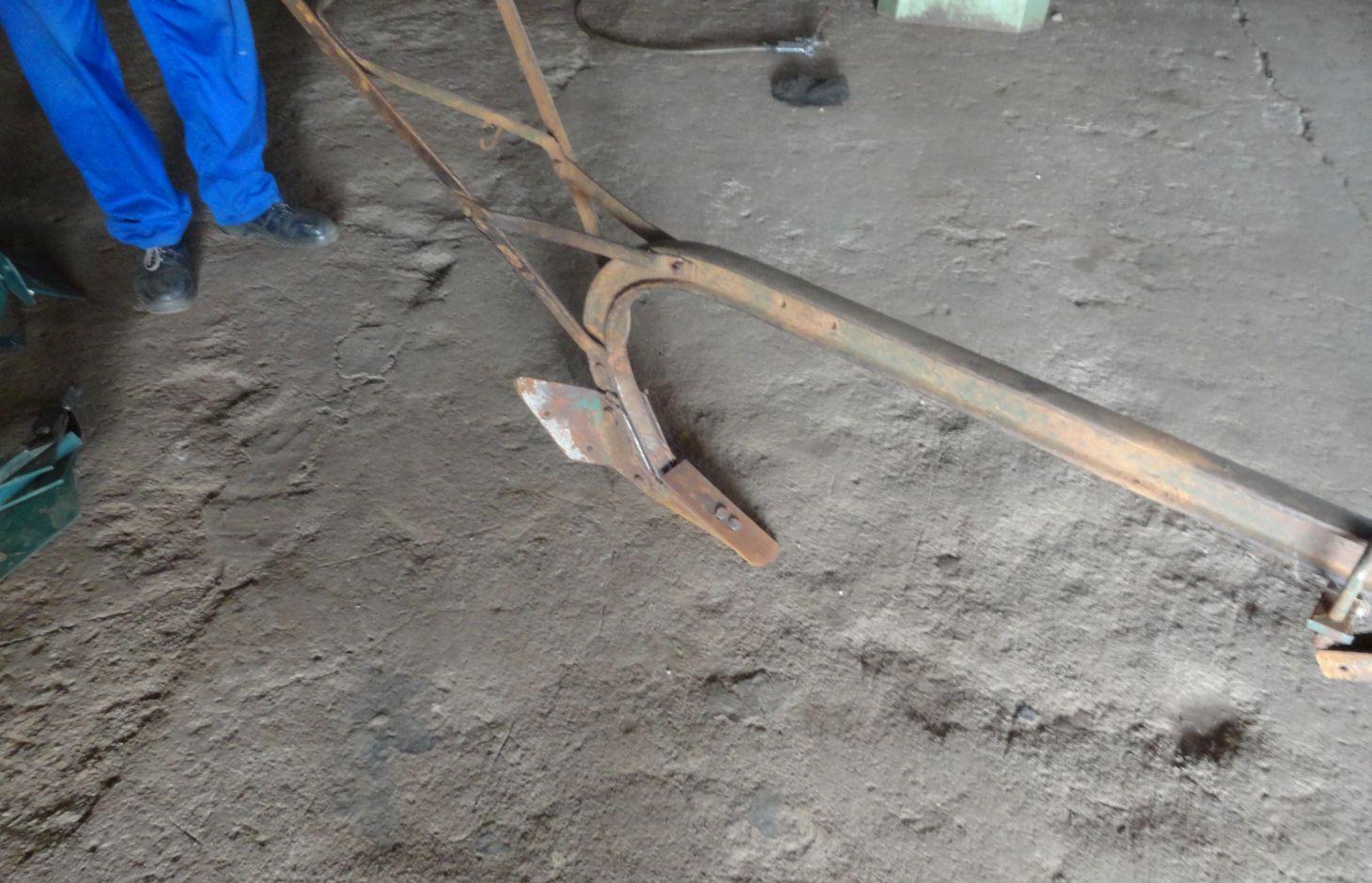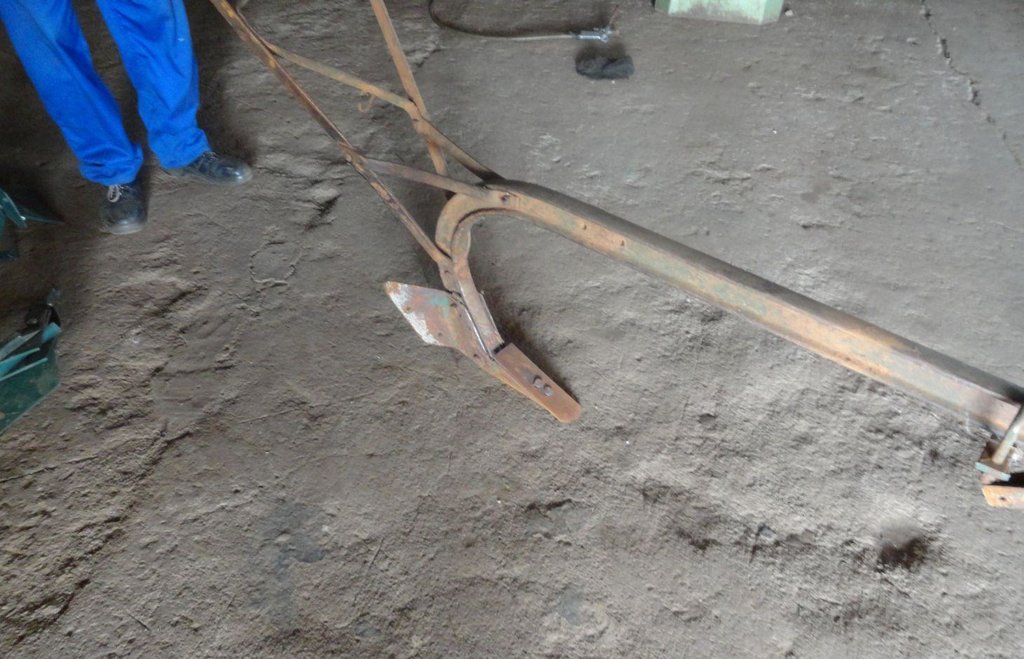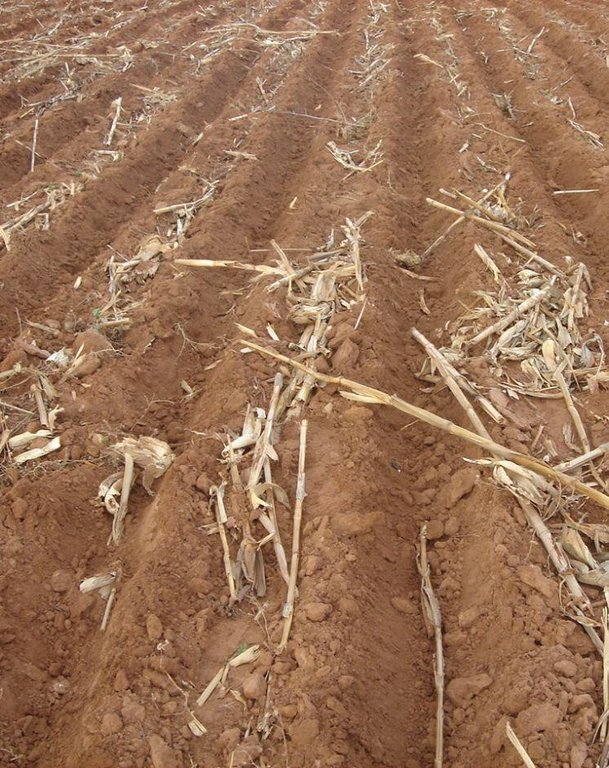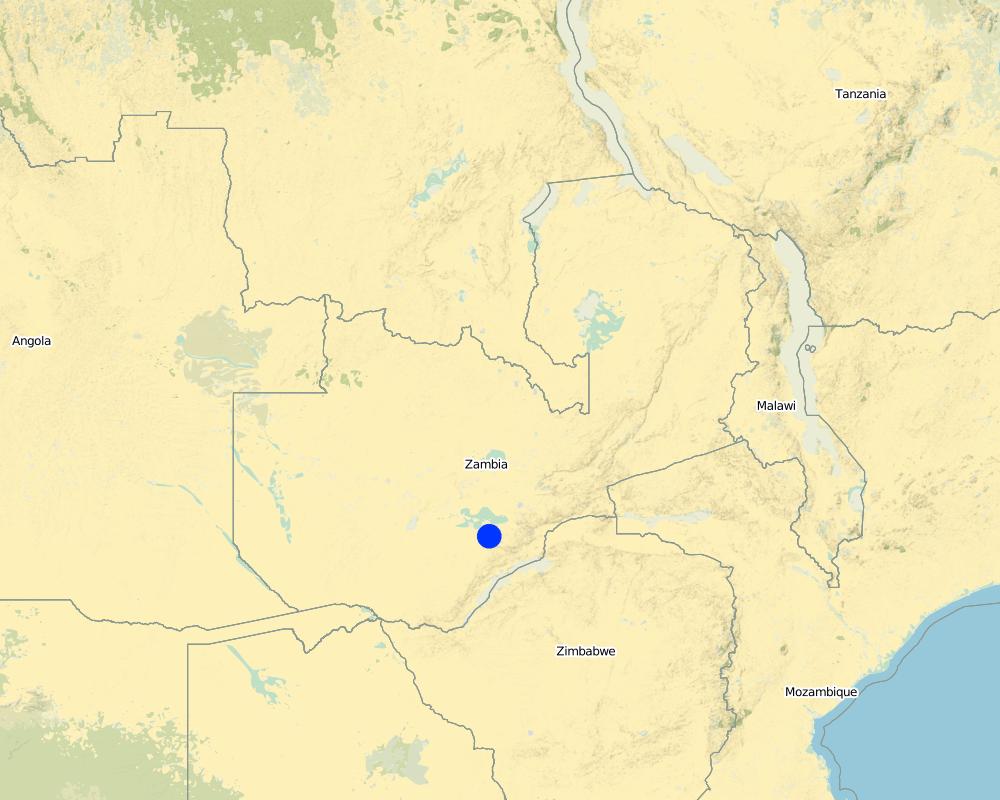Conservation Tillage with Magoye Ripper [赞比亚]
- 创建:
- 更新:
- 编制者: Silenga Wamunyima
- 编辑者: –
- 审查者: Fabian Ottiger
Minimum tillage
technologies_1139 - 赞比亚
查看章节
全部展开 全部收起1. 一般信息
1.2 参与该技术评估和文件编制的资源人员和机构的联系方式
SLM专业人员:
SLM专业人员:
Katoweji Alfred
(+260) 211 213 739
Golden Valley Agricultural Research Trust
PO. Box 50834 Lusaka
赞比亚
SLM专业人员:
Ndandula Sharon
(+260) 211 213 739
Golden Valley Agricultural Research Trust
PO. Box 50834 Lusaka
赞比亚
有助于对技术进行记录/评估的机构名称(如相关)
Golden Valley agricultural research trust (Golden Valley agricultural research trust) - 赞比亚1.3 关于使用通过WOCAT记录的数据的条件
(现场)数据是什么时候汇编的?:
15/01/2013
编制者和关键资源人员接受有关使用通过WOCAT记录数据的条件。:
是
1.5 请参阅有关SLM方法的问卷
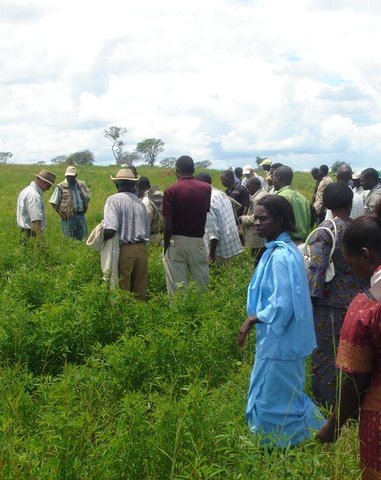
Participatory Research and Development [赞比亚]
This is a collaborative process between researchers and farmers for developing and adapting new technologies that focus on incorporating the perspectives and inputs from the farmers into the development process.
- 编制者: Arthur Chomba
2. SLM技术的说明
2.1 技术简介
技术定义:
Conservation Tillage with the Magoye Ripper is an animal draft reduced tillage method that involves the use of the Magoye Ripper to loosen the soil by shattering with a tine instead of ploughing.
2.2 技术的详细说明
说明:
The Magoye Ripper is an animal drawn implement used for conservation tillage. The Ripper consists of a frame that is attached to a common plough beam and on this frame is fixed a tine at an angle that penetrates and breaks up the soil when pulled. Only the region where the crop furrow will be is loosened by the tine and by so doing reducing the amount of tillage and disruption of soil structure while preserving the crop residue cover. The frame has some ‘wings’ attached to it that throw the soil out of the ripped furrow to leave it open for planting and collecting of water. Ripping is done in one pass up to a depth of 15cm depending on the strength of the oxen, soil type, hitch assembly settings and the sharpness of the tine.
Purpose of the Technology: Reducing tillage first of all reduces tillage costs and tillage time allowing more time for the farmer to plant early and/or a bigger area. Reducing tillage also reduces the loss of soil organic matter and the destructive effects to the soil structure ultimately improving soil fertility and soil water conservation. Ripping does not invert the soil, hence it does not bury crop residues which further enhance organic matter levels and protect the soil from excessive evaporation and erosion. The open furrow left by the ripper collects water from the adjacent untilled soil much in the same way basins (zai system) are used for water harvesting. This together with the increased rooting depth resulting from the breaking of compacted soil, enhanced infiltration and early planting improves water conservation and hence the resilience of crop to extended dry spells.
Establishment / maintenance activities and inputs: The establishment of ripping based conservation tillage mainly involves the purchase of the ripper frame and the
replaceable tines. Liming acidic soils (low pH soils) followed by a final ploughing will be required to correct the soil pH which otherwise will be difficult to correct once conservation tillage has been established. The main establishment activity involves adopting a new mindset and increasing the knowledge base to apply the technology correctly. Knowledge about alternative weed control practices and herbicide use is particularly cardinal as the farmer will have to adopt new weeding practices and routines in the absence of ploughing. Maintenance activities are more or less the same as conventional tillage except for replacing the tillage tines which wear every now and then. The same applies for the inputs except for the increase in use of herbicides.
Natural / human environment: Ripping is best performed in dry season when the soil is dry although this may not be possible with some of the smaller and/or weak oxen when the soil is too dry. It is therefore recommended for farmers in regions that experience long dry seasons to rip at the end of harvest before the soils get too dry and hard and when the oxen are in good condition before they lose weight and strength due to less feed and water, excessive heat as the dry season progresses.
The ripper is mostly suited to small-scale farmers just adopting Conservation Agriculture (CA) since the tool can be easily adapted to the existing plough beam which most of the farmers already have. The small capital outlay for establishing the system makes it suited to resource poor and risk-averse farmers.
2.3 技术照片
2.5 已应用该技术的、本评估所涵盖的国家/地区/地点
国家:
赞比亚
区域/州/省:
Zambia/Southern Province
有关地点的进一步说明:
Mazabuka/Magoye
Map
×2.6 实施日期
如果不知道确切的年份,请说明大概的日期:
- 10-50年前
2.7 技术介绍
详细说明该技术是如何引入的:
- 在实验/研究期间
注释(项目类型等):
The Magoye Ripper was introduced in 1995 after a period of adaptive research by government research branch under a project supported by the Netherlands government.
3. SLM技术的分类
3.1 该技术的主要目的
- 减少、预防、恢复土地退化
3.2 应用该技术的当前土地利用类型

农田
- 一年一作
主要农作物(经济作物及粮食作物):
Major cash crop: Cotton, maize
Major food crop: Maize
Major other crops: Groundnuts

混合(作物/放牧/树木),包括农林
- 农牧业
主要产品/服务:
Main species seminomadism/pastoralism: Cattle, goats, pigs
注释:
Major land use problems (compiler’s opinion): Loss of soil structure and loss of soil fertility
Major land use problems (land users’ perception): Droughts and dry dpells
Livestock is grazing on crop residues
3.3 有关土地利用的更多信息
该技术所应用土地的供水:
- 雨养
每年的生长季节数:
- 1
具体说明:
Longest growing period in days: 135 Longest growing period from month to month: Mid November to end of March
牲畜密度(如相关):
1-10 LU /km2
3.4 该技术所属的SLM组
- 最小的土壤扰动
3.5 技术传播
具体说明该技术的分布:
- 均匀地分布在一个区域
如果该技术均匀地分布在一个区域上,请注明覆盖的大致区域。:
- 0.1-1 平方千米
注释:
250 rippers were distributed in Magoye and surveys show that only about half of these farmers continued to use the ripper. The field sizes range from 1/4ha to 1/2ha.
3.6 包含该技术的可持续土地管理措施

农艺措施
- A2:有机质/土壤肥力
- A6:其它
注释:
Main measures: agronomic measures
Specification of other agronomic measures: Reduced Tillage, Crop Residues
Type of agronomic measures: early planting, mulching, manure / compost / residues, mineral (inorganic) fertilizers, soil conditioners (lime, gypsum), rotations / fallows, breaking compacted topsoil, minimum tillage, non-inversion tillage, furrows (drainage, irrigation), breaking compacted subsoil
3.7 该技术强调的主要土地退化类型

土壤水蚀
- Wt:表土流失/地表侵蚀

化学性土壤退化
- Cn:肥力下降和有机质含量下降(非侵蚀所致)

物理性土壤退化
- Pc:压实

生物性退化
- Bl:土壤寿命损失
注释:
Main type of degradation addressed: Cn: fertility decline and reduced organic matter content, Pc: compaction, Bl: loss of soil life
Secondary types of degradation addressed: Wt: loss of topsoil / surface erosion
Main causes of degradation: soil management (Over-ploughing), crop management (annual, perennial, tree/shrub) (Monocropping), overgrazing (Crop residues overgrazed leaving land exposed), poverty / wealth (under application of fertilizer leading to nutrient mining, charcoal burning)
Secondary causes of degradation: deforestation / removal of natural vegetation (incl. forest fires) (Charcoal burning), Heavy / extreme rainfall (intensity/amounts) (high intensity storms leading to erosion), droughts (resulting in inadequate soil cover), land tenure (communal land over-exploited), governance / institutional (lack of credit facilities)
3.8 防止、减少或恢复土地退化
具体数量名该技术与土地退化有关的目标:
- 减少土地退化
注释:
Secondary goals: prevention of land degradation, rehabilitation / reclamation of denuded land
4. 技术规范、实施活动、投入和成本
4.1 该技术的技术图纸
作者:
Silenga Wamunyima, Box 670577, Mazabuka, Zambia
4.2 技术规范/技术图纸说明
Planting rip lines are done at a depth of 15-20 cm with inter row of 75 or 90 cm, 30-40 cm depth of the furrow of ripping can be achieved. This is achieved by running the ripper through the same rip line twice so that the tine gets deeper into the soil. The width of the open furrow is 10-15 cm wide. Ripping is done across the slope to reduce runoff. Ripping is best performed and recommended done in the dry season.
Location: Magoye. Mazabuka/Southern Province/Zambia
Date: 2014-06-29
Technical knowledge required for field staff / advisors: high (The use of the Ripper itself is simple but applying it as part of a conservation agriculture system can be knowledge demanding.)
Technical knowledge required for land users: moderate (adapting the production system to accommodate the Ripper will require learning new practices for weeding, planting and fertility management.)
Main technical functions: improvement of ground cover, improvement of topsoil structure (compaction), improvement of subsoil structure (hardpan), increase of infiltration, water harvesting / increase water supply
Secondary technical functions: control of raindrop splash, improvement of surface structure (crusting, sealing), increase in organic matter, increase in nutrient availability (supply, recycling,…), increase / maintain water stored in soil, increase of groundwater level / recharge of groundwater
Early planting
Material/ species: maize, cotton
Quantity/ density: 44,000 pla
Remarks: 25cm intra row by 75cm
Mulching
Material/ species: crop residues
Quantity/ density: 3ton/ha
Remarks: uniformly spread
Manure / compost / residues
Material/ species: residues
Quantity/ density: 3ton/ha
Remarks: uniformly spread
Mineral (inorganic) fertilizers
Material/ species: Basal and top dressing
Quantity/ density: 400kg/ha
Remarks: spot application
Soil conditioners (lime, gypsum)
Material/ species: lime
Quantity/ density: 1ton/ha
Rotations / fallows
Material/ species: maize in rotation with cotton, groundnuts and cowpeas
Breaking compacted topsoil
Material/ species: Ripping with Magoye Ripper at 15cm depth
Remarks: 75cm or 90cm row spacing
Minimum tillage
Material/ species: ripping
Non-inversion tillage
Material/ species: ripping
Furrows (drainage, irrigation)
Material/ species: ripped lines leave furrows for water harvesting
Breaking compacted subsoil
Material/ species: deep ripping at 20cm
4.3 有关投入和成本计算的一般信息
其它/国家货币(具体说明):
Kwacha
注明美元与当地货币的汇率(如相关):1美元=:
5.0
注明雇用劳工的每日平均工资成本:
2.40
4.4 技术建立活动
| 活动 | 措施类型 | 时间 | |
|---|---|---|---|
| 1. | Purchase magoye ripper | 农业学的 | |
| 2. | Purchase knapsack sprayer | 农业学的 |
注释:
Lifespan of the magoye ripper: 7 years
Lifespan of the Knapsack sprayer: 5 years
4.5 技术建立所需要的费用和投入
| 对投入进行具体说明 | 单位 | 数量 | 单位成本 | 每项投入的总成本 | 土地使用者承担的成本% | |
|---|---|---|---|---|---|---|
| 设备 | Magoye ripper | Tool | 1.0 | 50.0 | 50.0 | 100.0 |
| 设备 | Knapsack sprayer | Tool | 1.0 | 80.0 | 80.0 | 100.0 |
| 技术建立所需总成本 | 130.0 | |||||
注释:
Duration of establishment phase: 5 month(s)
4.6 维护/经常性活动
| 活动 | 措施类型 | 时间/频率 | |
|---|---|---|---|
| 1. | slashing and spreading residues | 农业学的 | May-June yearly after harvest |
| 2. | Ripping | 农业学的 | May-June after harvest |
| 3. | Liming | 农业学的 | Nov-Dec before planting |
| 4. | Planting and fertilizing | 农业学的 | Nov-Dec at onset of rains |
| 5. | chemical weeding | 农业学的 | 3 times |
| 6. | harvesting | 农业学的 | April-May |
4.7 维护/经常性活动所需要的费用和投入(每年)
| 对投入进行具体说明 | 单位 | 数量 | 单位成本 | 每项投入的总成本 | 土地使用者承担的成本% | |
|---|---|---|---|---|---|---|
| 劳动力 | Slashing and spreading residues | ha | 1.0 | 20.0 | 20.0 | 100.0 |
| 劳动力 | Ripping | ha | 1.0 | 50.0 | 50.0 | 100.0 |
| 劳动力 | Liming | ha | 1.0 | 42.0 | 42.0 | 100.0 |
| 劳动力 | Planting and fertilizing | ha | 1.0 | 40.0 | 40.0 | 100.0 |
| 植物材料 | Seeds | kg | 20.0 | 2.5 | 50.0 | 100.0 |
| 肥料和杀菌剂 | Fertilizer | kg | 400.0 | 0.8 | 320.0 | 100.0 |
| 其它 | Herbicides | liters | 5.0 | 6.0 | 30.0 | 100.0 |
| 其它 | Labour: Chemical weeding | ha | 1.0 | 24.0 | 24.0 | 100.0 |
| 其它 | Labour: Harvesting | ha | 1.0 | 20.0 | 20.0 | 100.0 |
| 技术维护所需总成本 | 596.0 | |||||
注释:
Machinery/ tools: Magoye Ripper
Calculation are for a 1ha of maize under magoye ripper based conservation tillage and costs are for the Zambia situation in Magoye as of August 2012.
4.8 影响成本的最重要因素
描述影响成本的最决定性因素:
The weed control method employed is the main determinate factor depending on whether the farmer uses hand hoe or herbicides. Abandoning ploughing leads to higher weed densities leading to increased labour requirements/recurrent costs if hand weeding is used. However, with herbicides the weeding labour demand and costs cost are much lower by a factor of about 5. Another major cost is that of fertilizer which makes up about half the cost hence the total cost will vary significantly depending on fertilizer cost.
5. 自然和人文环境
5.1 气候
年降雨量
- < 250毫米
- 251-500毫米
- 501-750毫米
- 751-1,000毫米
- 1,001-1,500毫米
- 1,501-2,000毫米
- 2,001-3,000毫米
- 3,001-4,000毫米
- > 4,000毫米
有关降雨的规范/注释:
Average rainfall 700mm, summer rains from November to March.
农业气候带
- 半干旱
Thermal climate class: subtropics. 3 distinct seasons – summer, winter and one rainy season
5.2 地形
平均坡度:
- 水平(0-2%)
- 缓降(3-5%)
- 平缓(6-10%)
- 滚坡(11-15%)
- 崎岖(16-30%)
- 陡峭(31-60%)
- 非常陡峭(>60%)
地形:
- 高原/平原
- 山脊
- 山坡
- 山地斜坡
- 麓坡
- 谷底
垂直分布带:
- 0-100 m a.s.l.
- 101-500 m a.s.l.
- 501-1,000 m a.s.l.
- 1,001-1,500 m a.s.l.
- 1,501-2,000 m a.s.l.
- 2,001-2,500 m a.s.l.
- 2,501-3,000 m a.s.l.
- 3,001-4,000 m a.s.l.
- > 4,000 m a.s.l.
关于地形的注释和进一步规范:
Slopes on average: Also flat and moderate (classed 2) and rolling (classed 3)
5.3 土壤
平均土层深度:
- 非常浅(0-20厘米)
- 浅(21-50厘米)
- 中等深度(51-80厘米)
- 深(81-120厘米)
- 非常深(> 120厘米)
土壤质地(表土):
- 中粒(壤土、粉土)
- 细粒/重质(粘土)
表土有机质:
- 中(1-3%)
- 低(<1%)
如有可能,附上完整的土壤描述或具体说明可用的信息,例如土壤类型、土壤酸碱度、阳离子交换能力、氮、盐度等。:
Soil fertility: Low (classed 1) and medium (classed 2, low fertility caused mainly by poor soil management practices, otherwise soil are inherently fertile)
Topsoil organic matter: Low (classed 1) and medium (classed 2, due to excessive ploughing and nutrient mining)
Soil drainage/infiltration: Good (classed 1, soils naturally are well drained except were soil have bee compacted by poor management practices) and medium (classed 2)
Soil water storage capacity: Medium (classed 1, soils mostly loam to sandy loam with medium storage capacity) and low (ranked 2)
5.4 水资源可用性和质量
地下水位表:
> 50米
地表水的可用性:
中等
水质(未处理):
良好饮用水
关于水质和水量的注释和进一步规范:
Ground water table: <50m (ranked 1, hand wells are <20m but reliable boreholes are > 50m) and 5-50m (ranked 2)
Availability of surface water: Medium (mostly seasonal streams and dams)
Water quality (untreated): Good drinking water (ranked 1, from hand pumps (both communal and private)) and poor drinking water (treatment required, from hand dug wells, ranked 1 also)
5.5 生物多样性
物种多样性:
- 中等
关于生物多样性的注释和进一步规范:
Human population densities are relatively low
5.6 应用该技术的土地使用者的特征
非农收入:
- 收入的10-50%
相对财富水平:
- 非常贫瘠
- 贫瘠
个人或集体:
- 个人/家庭
性别:
- 男人
说明土地使用者的其他有关特征:
Land users applying the Technology are mainly common / average land users
Difference in the involvement of women and men: The technology is applied mostly by men since most households are male headed and animal traction operation are reserved for men. Planting and weeding operations are the domain of women and children
Population density: 10-50 persons/km2
Annual population growth: 3% - 4%
8% of the land users are rich and own 15% of the land (own more than 10 cattle).
8% of the land users are average wealthy and own 15% of the land (own between 5 and 10 cattle).
16% of the land users are poor and own 20% of the land (own less than 5).
68% of the land users are poor and own 40% of the land (do not own cattle).
Off-farm income specification: sale of rainfed crops makes up about half of their income, the remainder coming from sale of livestock, petty trading, hiring out labour and remittances
Market orientation of production system: Mixed (subsistence/ commercial, sale of excess maize and cotton, dairy, ranked 1) and subsistence (self-supply, livestock, maize and legumes for home consumption, ranked 2),
Level of mechanization: Animal traction (ranked 1, families without cattle borrow or hire), mechanised (ranked 2) and manual labour (ranked 2, only for small backyard fields)
5.7 应用该技术的土地使用者拥有或租用的平均土地面积
- < 0.5 公顷
- 0.5-1 公顷
- 1-2 公顷
- 2-5公顷
- 5-15公顷
- 15-50公顷
- 50-100公顷
- 100-500公顷
- 500-1,000公顷
- 1,000-10,000公顷
- > 10,000公顷
这被认为是小规模、中规模还是大规模的(参照当地实际情况)?:
- 小规模的
注释:
Average area of land owned or leased by land users applying the Technology: Also: 5-15 ha, 15-50 ha, 50-100 ha
5.8 土地所有权、土地使用权和水使用权
土地所有权:
- 个人,未命名
土地使用权:
- 自由进入(无组织)
- 个人
- Land is apportioned by traditional leaders
用水权:
- 自由进入(无组织)
- Land is apportioned by traditional leaders
5.9 进入服务和基础设施的通道
健康:
- 贫瘠
- 适度的
- 好
教育:
- 贫瘠
- 适度的
- 好
技术援助:
- 贫瘠
- 适度的
- 好
就业(例如非农):
- 贫瘠
- 适度的
- 好
市场:
- 贫瘠
- 适度的
- 好
能源:
- 贫瘠
- 适度的
- 好
道路和交通:
- 贫瘠
- 适度的
- 好
饮用水和卫生设施:
- 贫瘠
- 适度的
- 好
金融服务:
- 贫瘠
- 适度的
- 好
6. 影响和结论性说明
6.1 该技术的现场影响
社会经济效应
生产
作物生产
SLM之前的数量:
1.8ton/ha
SLM之后的数量:
2ton/ha
注释/具体说明:
mostly due to early planting
饲料生产
注释/具体说明:
crop residues needed for soil cover
生产故障风险
注释/具体说明:
Better tolerance to dry spells
生产区域
SLM之后的数量:
20%
收入和成本
农业投入费用
注释/具体说明:
purchase of herbicides
农业收入
SLM之后的数量:
15%
注释/具体说明:
due to lower tillage cost, better yield
工作量
注释/具体说明:
only if herbicicdes are used for weeding
社会文化影响
食品安全/自给自足
注释/具体说明:
due to improved yields and more time and labour to diversify
娱乐机会
注释/具体说明:
Less time spent preparing land
冲突缓解
注释/具体说明:
competition for crop residues with neighbours cattle
Improved livelihoods and human well-being
注释/具体说明:
Technology not yet been applied on a large enough area to make significant impact at community level but increased farm incomes among farmers has led to better education and health among household members.
生态影响
水循环/径流
水质
注释/具体说明:
due to improved good drainage
水的回收/收集
注释/具体说明:
open furows collect water
地表径流
注释/具体说明:
due to better soil cover
多余水的排放
注释/具体说明:
due to improved soil structure
地下水位/含水层
注释/具体说明:
not applied extensively
蒸发
注释/具体说明:
due to better soil cover
土壤
土壤水分
注释/具体说明:
due to resulting improved soil srtucture
土壤覆盖层
注释/具体说明:
Due to non-inversion tillage
土壤流失
注释/具体说明:
Due to less soil disturbance and better soil cover
土壤结壳/密封
注释/具体说明:
Due to less soil disturbance
土壤压实
注释/具体说明:
Due to less soil disturbance
养分循环/补给
注释/具体说明:
Due to less soil disturbance
盐度
注释/具体说明:
due to resulting good drainage
土壤有机物/地下C
注释/具体说明:
Due to less soil disturbance
生物多样性:植被、动物
生物量/地上C
注释/具体说明:
Due to less soil disturbance
动物多样性
注释/具体说明:
due to increased soil organic matter (SOM)
其它生态影响
Waterlogging
注释/具体说明:
Open furrow collect water in times of excess rainfal
Soil erosion locally
注释/具体说明:
If furrow are made along the slope
6.2 该技术的场外影响已经显现
水资源可用性
注释/具体说明:
only if applied on a large scale
旱季稳定可靠的水流
注释/具体说明:
only if applied on a large scale
下游洪水
注释/具体说明:
only if applied on a large scale
下游淤积
注释/具体说明:
only if applied on a large scale
地下水/河流污染
注释/具体说明:
only if applied on a large scale
对邻近农田的破坏
注释/具体说明:
only if applied on a large scale
6.3 技术对渐变气候以及与气候相关的极端情况/灾害的暴露和敏感性(土地使用者认为的极端情况/灾害)
渐变气候
渐变气候
| 季节 | 气候变化/极端天气的类型 | 该技术是如何应对的? | |
|---|---|---|---|
| 年温度 | 增加 | 未知 |
气候有关的极端情况(灾害)
气象灾害
| 该技术是如何应对的? | |
|---|---|
| 局地暴雨 | 不好 |
| 局地风暴 | 未知 |
气候灾害
| 该技术是如何应对的? | |
|---|---|
| 干旱 | 好 |
水文灾害
| 该技术是如何应对的? | |
|---|---|
| 比较和缓的(河道)洪水 | 不好 |
其他气候相关的后果
其他气候相关的后果
| 该技术是如何应对的? | |
|---|---|
| 缩短生长期 | 好 |
注释:
Magoye ripper based conservation tillage should be applied in well drained fields to avoid water-logging in the ripped furrows during seasons of excess rainfall or events of heavy downpours.
6.4 成本效益分析
技术收益与技术建立成本相比如何(从土地使用者的角度看)?
短期回报:
积极
长期回报:
非常积极
技术收益与技术维护成本/经常性成本相比如何(从土地使用者的角度看)?
短期回报:
积极
长期回报:
非常积极
注释:
Timely planting enables larger areas to be planted and better yields. In the long term, improved soil fertility and soil structure results in sustained improved yields. However, if herbicides are not used, the costs and labour requirements of weeding can result in negative benefits.
6.5 技术采用
注释:
250 land user families have adopted the Technology with external material support
Comments on acceptance with external material support: The farmers bought the Magoye Rippers at half price and over half of them abandoned the technology after the first or second year of use.
Comments on spontaneous adoption: Information on spontaneous adoption is not documented although there have been reports of this in other districts.
There is a little trend towards spontaneous adoption of the Technology
Comments on adoption trend: Availability of replacement tines and the increased weed challenge have been a major hindrances to widespread adoption.
6.7 该技术的优点/长处/机会
| 土地使用者眼中的长处/优势/机会 |
|---|
|
Enables early planting How can they be sustained / enhanced? planting with the first heavy rainfall in November |
| 编制者或其他关键资源人员认为的长处/优势/机会 |
|---|
|
necessitates early planting How can they be sustained / enhanced? Plant in November or early December with the onset of rainfall |
|
fewer operations hence lower costs How can they be sustained / enhanced? continuous emphasis on early land preparation (May to July/August) |
|
conserves water and soil How can they be sustained / enhanced? encourage crop diversification and crop rotation legumes |
6.8 技术的弱点/缺点/风险及其克服方法
| 土地使用者认为的弱点/缺点/风险 | 如何克服它们? |
|---|---|
| weeding is difficult when herbicides are not used | train land users on how to use herbicides |
| ripping is hardly attained in heavy soils in October | rip between May and July |
| 编制者或其他关键资源人员认为的弱点/缺点/风险 | 如何克服它们? |
|---|---|
| weed pressure | encourage land users to use herbicides and continuous weeding |
7. 参考和链接
7.2 参考可用出版物
标题、作者、年份、ISBN:
Impact study on the acceptance of the Magoye Ripper, Piet Stevens, David Samazaka, Ab Wanders, Douglas Moono, 2002
可以从哪里获得?成本如何?
GART/free
标题、作者、年份、ISBN:
Social-economic analysis of conservation agriculture in southern Africa, FAO, 2011
可以从哪里获得?成本如何?
FAO/free online
标题、作者、年份、ISBN:
Conservation farming in Zambia, Steven Haggblade, Gelson Tembo, October 2003
可以从哪里获得?成本如何?
INDABA Project, Michigan State University/free online.
标题、作者、年份、ISBN:
Conservation farming in Zambia, Conservation farming unit (CFU), 2011
可以从哪里获得?成本如何?
cfu@zamnet.zm
链接和模块
全部展开 全部收起链接

Participatory Research and Development [赞比亚]
This is a collaborative process between researchers and farmers for developing and adapting new technologies that focus on incorporating the perspectives and inputs from the farmers into the development process.
- 编制者: Arthur Chomba
模块
无模块


